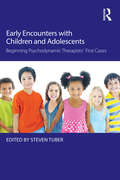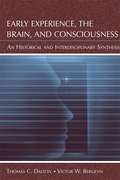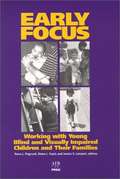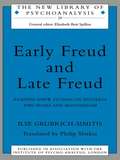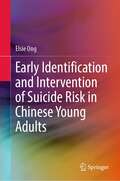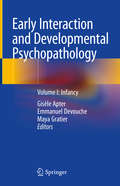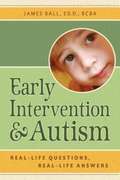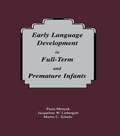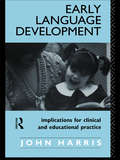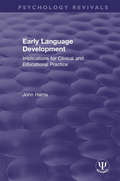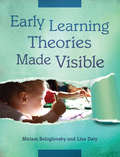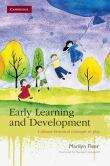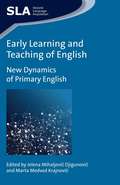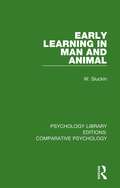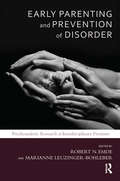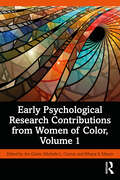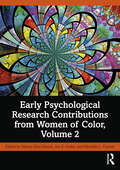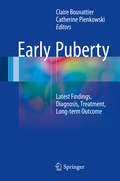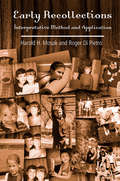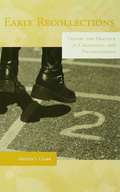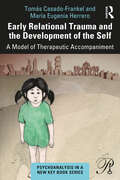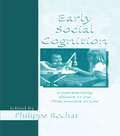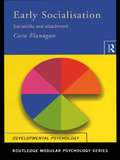- Table View
- List View
Early Encounters with Children and Adolescents: Beginning Psychodynamic Therapists’ First Cases
by Steven TuberEarly Encounters with Children and Adolescents is the first training guide to use the works of beginning therapists as its focus. Far too often, therapists in training are given the "classics" to read—case histories by the masters in the field, which can sometimes leave beginning therapists intimidated or even in despair as to whether they can ever reach that level of proficiency. This book is the first to remediate that situation by providing beginners with role models they can more easily internalize through realistic case histories that reveal the ins and outs of starting in a craft that is never fully mastered. Not only are the cases themselves fascinating, but the therapists also refer to the processes they struggled with while treating these patients. Readers will thus have a striking new counterweight to the classics they will still want to read as they progress in the field. Eight beginning clinicians discuss aspects of their clinical process, including: issues of transference and countertransference; the role of supervision; doing parent consultations, especially when one is not yet a parent; cultural/racial/socioeconomic differences between patient and therapist; and the vulnerability of not understanding for long moments in treatment. Psychodynamic beginners in every discipline will find these case histories compelling, heartfelt and inspiring.
Early Experience, the Brain, and Consciousness: An Historical and Interdisciplinary Synthesis
by Thomas C. Dalton Victor W. BergennThis new book examines the interrelationship between neuroscience and developmental science to help us understand how children differ in their capacity to benefit from their early motor and cognitive experiences. In so doing, it helps us better understand how experience affects brain growth and a childs capacity to learn. In this interdisciplinary
Early Focus: Working With Young Blind or Visually Impaired Children and Their Families
by Jessica S. Lambert Diane L. Fazzi Rona L. PogrundStressing the importance of early intervention in working with children with visual impairment, Pogrund (formerly special education, California State U.) and Fazzi (special education, California State U.) offer practitioners (teachers and other specialized professionals) an edited guide to working with children under age five. Eleven chapters review the developmental areas that are likely to be affected by vision loss and discuss the theory and knowledge base behind suggested educational practices in these areas. Chapters cover working with families, medical and functional implications, cognitive development, literacy, social development, promotion of independence and daily living skills, behavioral supports, motor and mobility development, and working with other professionals. Annotation (c)2003 Book News, Inc., Portland, OR (booknews.com)
Early Freud and Late Freud: Reading Anew Studies on Hysteria and Moses and Monotheism (The New Library of Psychoanalysis)
by Ilse Grubrich-SimitisIlse Grubrich-Simitis, well-known as a Freud scholar and editor of Freud's works, has long advocated a return to his original texts in order to comprehend fully the power and innovative force of his theories. In Early Freud and Late Freud she examines the earliest psychoanalytic book, Studies on Hysteria, which Freud wrote together with Breuer, and Moses and Monotheism, Freud's last book. The essay on Studies on Hysteria reveals to the reader why that book is indeed the 'primal book' of psychoanalysis. Not only does it offer a moving and dramatic account of the birth of the psychoanalytic method, but by introducing the key concept of trauma it establishes a foundation on which much of modern psychoanalysis has been built. Freud was to return to his original theory of trauma in his last book, Moses and Monotheism, where he developed it further in the light of his intervening researches. On the basis of her study of the Moses manuscripts and by applying the psychoanalytic method, Ilse Grubrich-Simitis shows how contemporary traumatic events in Nazi Germany may have influenced this return to the beginning and the intensification of Freud's self-analysis. This in turn was to lead to new insights into archaic forms of defence, pointing the way forward for modern psychoanalysis. Elegantly constructed and persuasively argued, Early Freud and Late Freud re-establishes the importance of two major Freudian texts, offering a new understanding of their significance.
Early Identification and Intervention of Suicide Risk in Chinese Young Adults
by Elsie OngThis book presents a concise introduction to the contemporary research and practice of suicide prevention, and it addresses the cognitive and neurological aspects of suicide. With the inclusion of extensive thought-provoking material, this book is of great value to clinicians, researchers, educators, students, and anyone who are broadly interested in suicide assessments and interventions. The authors' overview of different theories of suicide is also particularly useful for anyone aiming to understand and appropriately respond to the suicidal behavior of individuals, in particular, young adults and students. The erudite authors' analysis of the research topics within suicide makes this book valuable to educators, students, and researchers who care about prevention and protection from suicide. As the book addresses common issues in treating individuals at risk of suicide, this represents an essential resource for anyone working with this high-risk population. Since this substantive and authoritative book shows for the first time how innovative tools such as neuroimaging tools and mobile apps can be used in suicide intervention, this book is a useful resource for all those interested in keeping up-to-date with recent research and practice in suicide.
Early Interaction and Developmental Psychopathology: Volume I: Infancy
by Gisèle Apter Emmanuel Devouche Maya GratierThis first book of a two-volume series describes current research and state of the art clinical practice the shed light on the developmental origins of psychopathology in the first year of life, i.e. approximately up to the emergence of secondary intersubjectivity and/or walking. The second volume explores the interactional underpinnings of psychopathology in toddlerhood, from the time of voluntarily gross motor functioning to the emergence and basic organization of symbolic language at 24-30 months. A comprehensive approach is adopted, focusing on the fundamentally interactive nature of early development and examining interactions both with caregivers and more broadly with the socio-cultural environment. The books describe the processes involved in psychopathological trajectories and provide clinical insight into tailored, culturally sensitive therapeutic care in diverse environments. This volume discusses in detail situations placing the infant at risk and the nature of infant development, including communication, intersubjectivity, functional development, and affective and emotional development. Culturally and socially sensitive approaches to psychopathology are examined, with examples of specific infant- and family-centered therapies. Information on risk of abuse and neglect and infant protection policies is included.
Early Intervention and Autism: Real-Life Questions, Real-Life Answers
by James Ball<p>Leave behind confusing textbooks and unreliable websites. This book will guide you through your child's early years by providing sound advice based on over twenty years of experience. In an easy-to-read, question-answer format, Dr. Jim explains what makes your child tick, how to get the most out of early intervention services, and how to choose the most effective treatment options. <p>Helpful features include: <p> <li>10 Common Myths about Children with ASD, <li>7 Effective Teaching Strategies, <li>10 Behavior Rules to Live By, and <li>Must-have EI Goals and Objectives for Children with ASD.</li> <p> <p>In a special how-to section in the book, Dr. Jim walks you through a typical day in the life of a young child with autism, from the time the child wakes up to the time he goes to bed. You will learn what to do (and not do), what to say (and not say), and how to use the strategies outlined in the book to teach your child new skills, manage behavior, and have fun while learning! No matter what your level of "autism expertise," this is your game plan to start working with your child right away!</p>
Early Intervention in Psychiatry
by Peter Byrne Alan RosenEarly intervention (EI) is the single most important advance in mental health care in recent decades, representing a key shift in both theoretical standpoint and service delivery.Early Intervention in Psychiatry clearly describes best practice for extending this approach to all psychiatric disorders. Beginning with the rationale for EI, it informs interventions in people from all age groups across the lifespan, from perinatal to old age. It addresses EI in specific settings, such as primary health care, community health, the general hospital, non-government agencies, and in social movements, and for specific disorders including depression and anxiety, alcohol and substance use, childhood disorders, psychoses, bipolar disorders, eating disorders and borderline personality disorders.Early Intervention in Psychiatry is an essential guide for all psychiatrists, general practitioners, family physicians and public health doctors. It is also a valuable resource for mental health professionals and primary care colleagues, including nurses, social workers, psychologists, occupational therapists, vocational rehabilitation specialists, peer and support workers and for mental health commissioners and policy-makers.
Early Language Development in Full-term and Premature infants
by Paula Menyuk Jacqueline W. Liebergott Martin C. SchultzDesigned to provide practical information to those who are concerned with the development of young children, this book has three goals. First, the authors offer details about patterns of language development over the first three years of life. Although intensive studies have been carried out by examining from one to 20 children in the age range of zero to three years, there has been no longitudinal study of a sample as large as this--53 children--nor have as many measures of language development been obtained from the same children. Examining language development from a broad perspective in this size population allows us to see what generalizations can be made about patterns of language development. This volume's second goal is to examine the impact of such factors as biology, cognition, and communication input--and the interaction of these factors--which traditionally have been held to play an important role in the course of language development. The comparative influence of each--and the interaction of all three--were examined statistically using children's scores on standard language tests at age three. The volume's third goal is to provide information to beginning investigators, early childhood educators, and clinicians that can help them in their practice. This includes information about what appear to be good early predictors of language development at three years; language assessment procedures that can be used with children below age three, how these procedures can be used, what they tell us about the language development of young children; and what warning signs should probably be attended to, and which can most likely be ignored. In addition, suggestions are made about what patterns of communicative interaction during the different periods of development seem to be most successful in terms of language development outcomes at three years, and what overall indications the study offers regarding appropriate intervention.
Early Language Development: Implications for Clinical and Educational Practice
by John HarrisLanguage is of central importance in children's education and development, so providing help for the child suspected of having language difficulties is clearly of vital concern. Providing such help, or advising a teacher or parent on how best to proceed is, however, far from straightforward. Early Language Development draws together in a single volume the results of the very latest findings on language development and shows practitioners how best they can make use of them. In particular, special emphasis is given to the two most important practical questions for the practitioner: How can I find out exactly what the problem is? and What can I do about it?
Early Language Development: Implications for Clinical and Educational Practice (Psychology Revivals)
by John HarrisLanguage is of central importance in children’s development and vital for their success at school and in the world beyond. Designed for the many professionals involved in encouraging language development, Early Language Development, originally published in 1990, will enable them to get to grips with the practical issues of helping children with language difficulties. John Harris provides an invaluable summary of recent research on language development and how it relates to the practical concerns of language assessment and language teaching. Readers are given a clear account of the ways in which research has expanded our understanding of just what language is and how this has led to different approaches to language assessment. Various theories of language development are summarised and discussed in terms of their implications for language teaching. Dr Harris also describes different ways of encouraging language development and explains how teachers and therapists can overcome the special problems faced by children with particular difficulties, such as visual impairment, hearing impairment, general learning difficulties, and environmental deprivation. With its emphasis on the relevance of research-based knowledge to practical concerns, the book provides a useful bridge between the world of research and practice. It will be of particular interest to teachers of young children, speech therapists, and child psychologists, as well as to students taking courses on child development, and to parents of young children.
Early Learning Theories Made Visible
by Miriam Beloglovsky Lisa DalyGo beyond reading about early learning theories and see what they look like in action in modern programs and teacher practices. With classroom vignettes and colorful photographs, this book makes the works of Jean Piaget, Erik Erikson, Lev Vygotsky, Abraham Maslow, John Dewey, Howard Gardner, and Louise Derman-Sparks visible, accessible, and easier to understand. Each theory is defined--through engaging stories and rich visuals--in relation to cognitive, social-emotional, and physical developmental domains. Use this book to build a stronger comprehension of the foundations of early learning theories and become more reflective and intentional in your work with young children.
Early Learning and Development
by Marilyn FleerEarly Learning and Development provides a unique synthesis of cultural-historical theory from Vygotsky, Elkonin and Leontiev in the 20th century to the ground-breaking research of scholars such as Siraj-Blatchford, Kratsova and Hedegaard today. It demonstrates how development and learning are culturally embedded and institutionally defined, and it reflects specifically upon the implications for the early childhood profession. Divided into three parts, with succinct chapters that build upon knowledge progressively, the everyday lives of children at home, in the community, at preschool and at school are discussed in the context of child development and pedagogy. The book explicitly problematises the foundations of early childhood education, inviting postgraduates, researchers and academics to drill down into specific areas of international discourse, and extending upper-level undergraduates beyond the fundamental underpinnings of their learning. Ultimately Early Learning and Development offers new models of 'conceptual play' practice and theory within a globally resonant, cultural-historical framework.
Early Learning and Teaching of English
by Marta Medved Krajnović Jelena Mihaljević DjigunovićThis book offers an insight into the dynamics and complexities of learning and teaching English as a foreign language at primary level. Taking a Dynamic Systems Theory perspective, the chapters present the findings of longitudinal research undertaken in Croatia into the development of English in young learners. The book includes both qualitative and quantitative research and provides insights into internal individual learner factors and external micro and macro contextual factors which impact English learner development. Importantly, it tackles the unique position of English in today's globalised world in detail. It therefore makes a major contribution to work on learning English by the digitalised generation and to understanding the impact of practices in the modern EFL classroom. The volume will appeal to anyone interested in new ways of researching the complex and dynamic phenomenon of the early learning of English.
Early Learning in Man and Animal (Psychology Library Editions: Comparative Psychology)
by W. SluckinOriginally published in 1970, this is a survey of findings on the learning of young animals and human infants. In an attempt to discover some of the characteristic features of early learning, it examines all types of learning from conditioning and the primitive process known as ‘imprinting’, usually associated with ducklings, to the beginnings of understanding and language. The so-called ‘critical’ periods for social learning and personality development are considered at some length, and a close look is taken at research methods used in studying early learning, and at the needs and problems of current research. As a textbook for students of psychology, biology and sociology this book would have been invaluable at the time of publication. It should still also be of interest to research workers in the fields of animal behaviour and developmental psychology, and to practising psychologists, psychiatrists and social workers, as it is an up-to-date summary of all the knowledge concerning early learning at the time.
Early Parenting and Prevention of Disorder: Psychoanalytic Research at Interdisciplinary Frontiers (The\developments In Psychoanalysis Ser.)
by Robert N. EmdeThis book is devoted to a topic that is fundamental value for psychoanalytic research; namely a quest for the roots of psychopathological impediments and disorders as well as the related question as to what extent these developmental disturbances can be avoided by adequate early parenting.
Early Psychological Research Contributions from Women of Color, Volume 1
by Jon Grahe Rihana S. Mason Michelle L. CeynarEarly Psychological Research Contributions from Women of Color, Volume I, collects the dissertations of 20 cultural pioneers: women of color who were among the first to earn their doctorate degrees in psychology. Collectively, these chapters offer an important resource to diversify the history of psychology. This book is structured so that each chapter provides a biographical sketch of the woman, a summary of the dissertation, a reproducibility critique, a discussion about a modern alternative theory or methodological approach associated with the work (feminist theory, ethnopsychology, liberation psychology, etc.), and examples of how the dissertation can be used as instructional content in psychology and related disciplines offers suggestions for classroom use. The dissertations were completed as early as 1912 and as late as 1979 with the range reflecting differences in when women of certain groups could access education. The topics also range broadly across the breadth of the field of psychology, including physiological, cognitive, developmental, social, clinical, and more topics. The diversity of the work collected here will allow this book to be used to augment coursework either as a complete collection or as individual chapters. Instructors and students in undergraduate and graduate Research Methods courses will find this a crucial text in maintaining a true and inclusive historical perspective of psychological research. Additionally, due to the inclusion of research spanning the breadth of Psychology, this edited volume will appeal to scholars both across the discipline and in related fields, such as Women's Studies, Cognitive Science, Education, and Cultural Studies.
Early Psychological Research Contributions from Women of Color, Volume 2
by Jon E. Grahe Michelle L. Ceynar Rihana Shiri MasonThis volume serves as a companion to Early Psychological Research Contributions from Women of Color, Volume I. It focuses on the dissertations of 20 builders, women of color who earned their doctoral degrees in psychology prior to 1990 and who were leaders in the field through their leadership or innovation.An introductory chapter bridges the two volumes. Each subsequent chapter summarizes and examines a dissertation using a consistent format, including a biographical sketch of the builder with an emphasis on her significant contribution to an organization or innovation that moved the field forward, a summary of the dissertation, a reproducibility critique of the dissertation, and an alternative framework section that analyzes the dissertation from a modern theoretical perspective or methodological approach (e.g., feminist theory, liberation psychology, mestiza consciousness, etc.).The topics cover the breadth of the discipline of psychology, including physiological, cognitive, developmental, social, and clinical. Some topics are also relevant to business, education, medicine, and social work. The varying nature of these dissertations allows the book to be used to augment coursework either as a complete collection or as individual chapters.This volume is intended for both instructors and students. The course activities provide examples of how to integrate key aspects of the dissertation research into the classroom. The volume was written with upper-level undergraduate students in mind so that it could be used across the psychology curriculum, but the editors envision this book as a potential graduate-level text as well.
Early Puberty
by Claire Bouvattier Catherine PienkowskiThis book focuses on the state of the art in fully grasping precocious puberty and its consequences, incorporating advances in the areas of endocrinology, genetics, imaging and therapeutics to offer an indispensable tool for all physicians interested in the latest advances in this field. The authors present the latest findings on early puberty in girls and boys. The dynamic process of maturation is influenced by many signals and reshapes growing children's role within their environment. Readers will benefit from the educational value and level of depth of the individual chapters; written by respected experts and in a self-contained format, they can also be read separately to address specific interests.
Early Recollections: Interpretive Method and Application
by Harold H. Mosak Roger Di PietroOur present and our past are manifestly intertwined. Memories are not identical simulations of the past, but are stories shaped by our current perspectives of others, the world, and ourselves. As a result, the gathering of early recollections can be used as a projective technique that indicates our strengths, goals, lines of movement, fears, and a host of other relevant psychological data. Early Recollections are a quick, accurate, and cost-effective personality assessment demonstrated to have similar reliability and validity to other personality measures. Both a comprehensive and accessible text, Early Recollections: Interpretative Method and Application presents a constructivist approach and systematic development of early recollection theory. Mosak and Di Pietro invite students to think and actively engage in problem solving rather than merely read for content. Supported by step-by-step examples, this book also offers a perspective suitable for application by Adlerian practitioners, non-Adlerian clinicians, and all other mental health professionals and students seeking a new framework for evaluating personality.
Early Recollections: Theory and Practice in Counseling and Psychotherapy
by Arthur ClarkThis book reviews the extensive literature on early recollections and organizes various interpretive systems of evaluating early memories. The practitioner will find specific and detailed guidelines for administering and interpreting early recollections to help integrate these memories into counseling and psychotherapy. Following a carefully articulated contextual approach to early recollections, which synthesizes three perspectives - subjective, interpersonal and objective - come suggestions for using early recollections in the counseling process and a full-length case study to explicate the model and demonstrate the utility of using this approach.
Early Relational Trauma and the Development of the Self: A Model of Therapeutic Accompaniment (Psychoanalysis in a New Key Book Series)
by Tomás Casado-Frankel María Eugenia HerreroThrough the attentive examination of a single case study, this book weaves together the lived experiences of a clinician in training with those of their teenage patient, as they collectively navigate and overcome the profound effects of early relational trauma on the development of the self. By the care taken in their analysis, the book's authors deepen readers' understanding of attachment disorders and their clinical presentation whilst allowing for a uniquely human view of the interactions between patient and clinician. Elegantly combining poetic prose with a clinical account, this book invites readers to travel with the clinician, to think and feel in tandem with his subjective experiences, and to explore psychoanalytic and systems theory as a means to understand clinical relationships that are seldom written about with such vulnerability. It is a story of determination and growth both moving and enlightening. By giving form to the resilience of both patient and clinician, their mutual strength through "tears of change", this book expounds the behavioral consequences and treatment of psychopathologies associated with early relational trauma. In this way, the book will prove essential for all psychoanalysts and psychotherapists working with traumatized children and adolescents.
Early Social Cognition: Understanding Others in the First Months of Life
by Philippe RochatIn recent years, much stimulating research has emerged on children's theories of mind, construed as the understanding of others' intentions, beliefs, and desires. In this context, there is a renewed interest in the developmental origins of social cognition. This book is an expression of this new interest, assembling current conceptualizations and research on the precursors of joint engagement, language, and explicit theories of mind. The focus is on what announces such remarkable development. The book is divided into four parts. Part I deals with the nature and development of social cognition in infancy. Each contribution provides a different view of the important features of social cognition in the first months of life. Part II presents recent empirical findings on the developing ability by young infants to detect whether caretakers and social partners are attentive and responsive to their own behavior in social exchanges. Part III focuses on the early development of infants' ability to monitor others in their action, their gazing, their animacy, and their emotion. Part IV offers a commentary on the contributions as a whole, discussing the basic theoretical assumptions guiding current research on early social cognition. The author identifies the conceptual strengths and weaknesses of the work presented and suggests interesting avenues for future research.
Early Social Interaction
by Michael A. ForresterWhen a young child begins to engage in everyday interaction, she has to acquire competencies that allow her to be oriented to the conventions that inform talk-in-interaction and, at the same time, deal with emotional or affective dimensions of experience. The theoretical positions associated with these domains - social action and emotion - provide very different accounts of human development and this book examines why this is the case. Through a longitudinal video-recorded study of one child learning how to talk, Michael Forrester develops proposals that rest upon a comparison of two perspectives on everyday parent-child interaction taken from the same data corpus - one informed by conversation analysis and ethnomethodology, the other by psychoanalytic developmental psychology. Ultimately, what is significant for attaining membership within any culture is gradually being able to display an orientation towards both domains - doing and feeling, or social action and affect.
Early Socialisation: Sociability and Attachment
by Cara FlanaganEarly Socialisation looks at sociability and attachment and how they relate to emotional and cognitive development. Topics covered include: bonding, attachment, deprivation, separation and privation, as well as enrichment. Social and cultural variations are considered, and theories of attachment and loss are described and evaluated.
